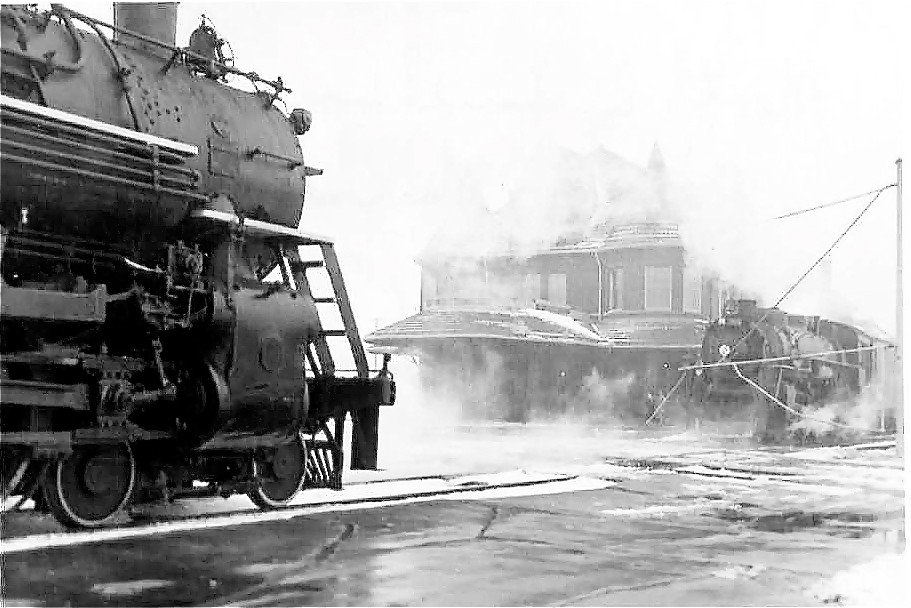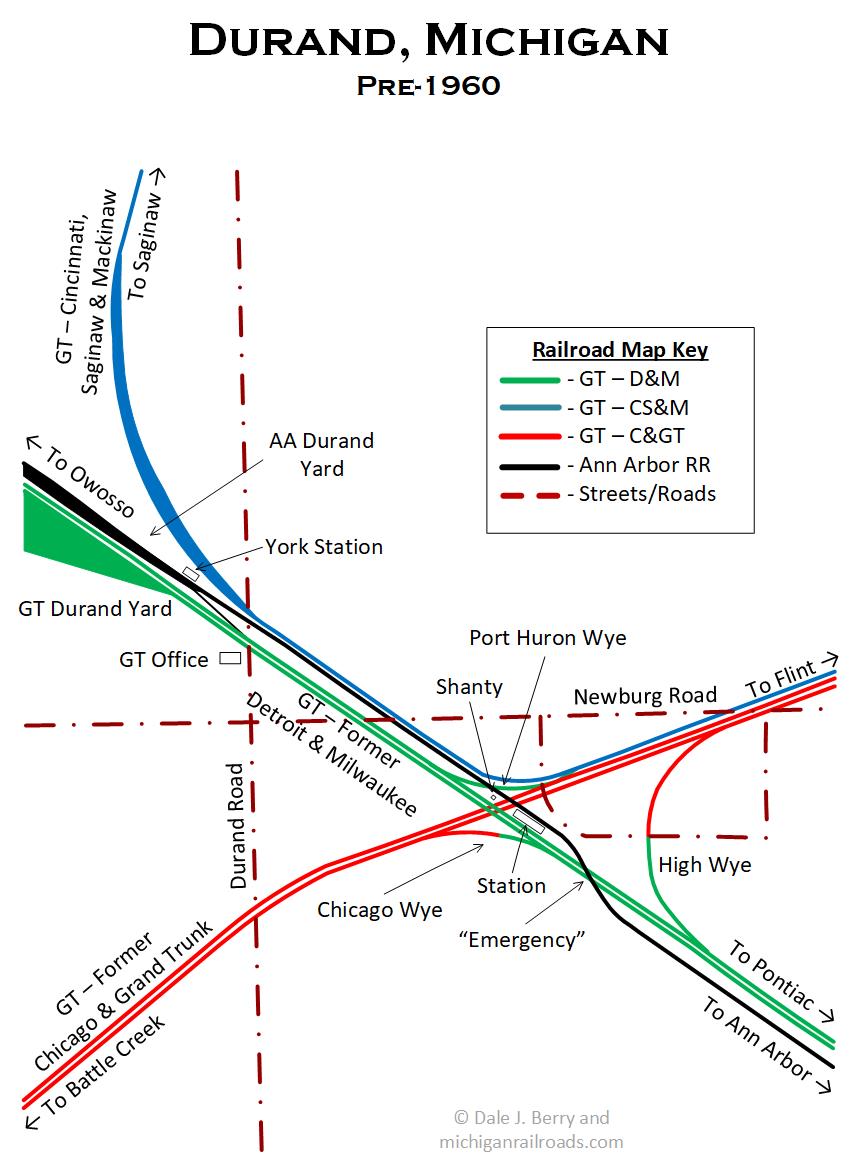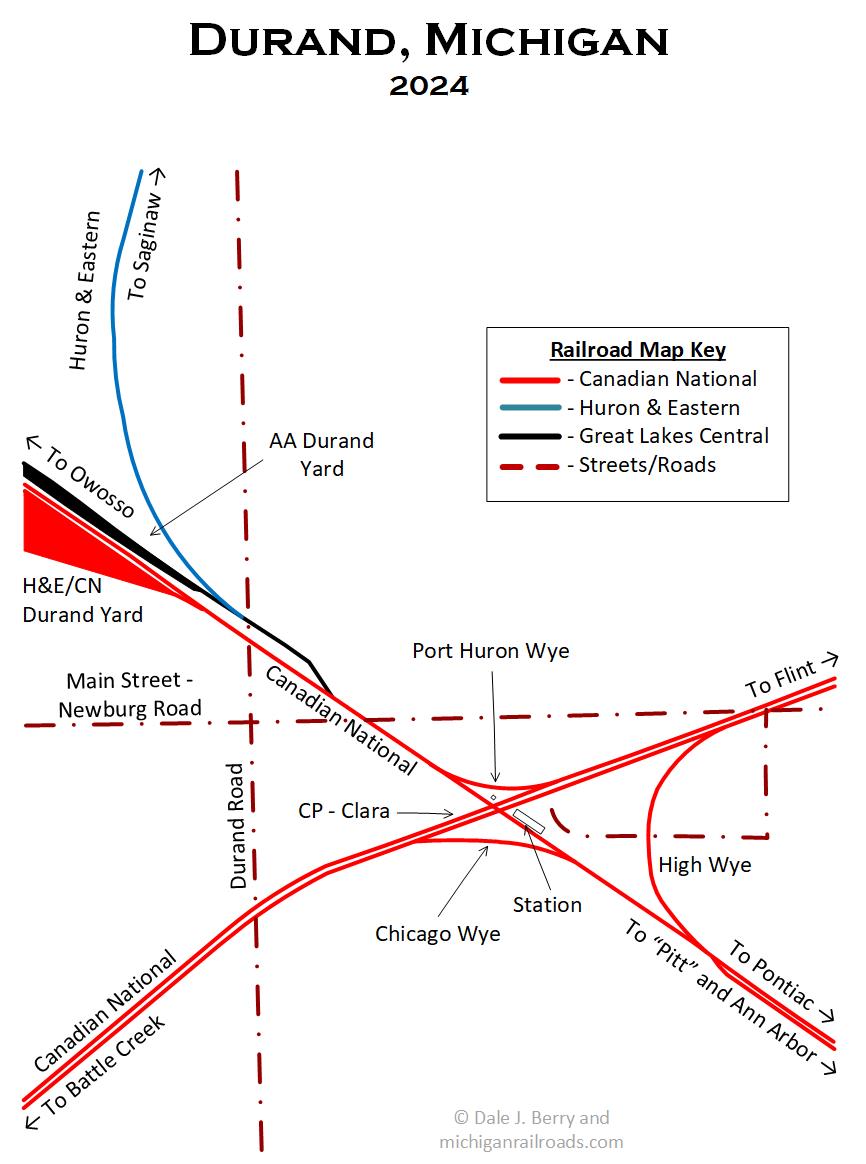- Details
- Hits: 130
Location: Durand, MI - Crossing Control

 Durand, Michigan was one of the most famous and most photographed railroad crossings in Michigan. It was a very busy crossing in its day, and still is today.
Durand, Michigan was one of the most famous and most photographed railroad crossings in Michigan. It was a very busy crossing in its day, and still is today.
The Detroit & Milwaukee railroad came through here first in 1858 on it's way to Grand Haven. The town, then known as Vernon Center, was a station stop but not a significant location on the railroad. All of that changed 19 years later when the Chicago & Grand Trunk was constructed from Flint to Lansing, through Durand in 18771. The town, which had been renamed Durand in 1876, quickly became a busy railroad junction.
Image info: Top image, two GTW passenger trains cross at Durand in 1955. Note the gated crossing which was operated by the switch-tender. Other gates protected the Ann Arbor railroad crossing nearby. [Robert Wanner collection]. 2nd image, a depiction of Durand trackage pre-1960 during the passenger train era. According to Sanborn maps [SBM], this track arrangement remained from the late 1800's until the 1970's. [Drawing by Dale Berry].
In the late 1880's, two other railroads came to Durand. The Toledo, Ann Arbor and Northern Michigan railroad built north from Toledo to Frankfort in 1886, and the Toledo, Saginaw & Mackinaw (renamed the Cincinnati, Saginaw & Mackinaw and leased by the GT) built a branch from Durand to Bay City in 18882. Four railroad lines now connected at Durand3.
Many photographs have documented the interchange of passenger trains here, pulling up to the crossing "nose to nose" in all directions. Some of these photographs were obviously staged, but the heavy interchange of passengers, especially on the GT, is undisputed.
In the late 1870's when the Durand crossings were created, the Michigan Commissioner of Railroads was increasingly concerned about railroad grade crossing accidents. With the invention of the railroad interlocker (brought to the U.S. from England), the Commissioner began ordering mechanical interlockings installed at most railroad crossings. Over the next 25 years, hundreds of crossings were interlocked. Even smaller branch line crossings received interlockings and control towers4.
Durand, as busy at it was and with at least nine "diamond" crossings, was never interlocked during its formative years. The crossings were manually protected by gates instead.
Why? It was just too busy. Trains from all directions needed to exchange passengers between the crossing lines, necessitating the "nose to nose" trains to transfer passengers, luggage and express freight.
So, how did this work? Without an interlocker, state law required all trains to stop and flag the crossing. In Durand's case, the flagging was done by a switch-tender with the help of his crossing gates.
The layout at Durand was slightly different in 1877. For the first 46 years, the original "Milwaukee" depot was on the old D&M main line, northwest of the crossing. In 1902, the present Durand Union Station was built southeast of the crossing at its current location. The Ann Arbor railroad crossed the D&M just south of the station (at a place known as "Emergency"5) and came up along the other side of the depot to discharge passengers. It then crossed the GT main line, crossed what is now the Port Huron wye, and headed northwest by the yard at York on the way to Owosso (see pre-1960 map). .jpg) As a result, the new depot was entirely surrounded by tracks on all sides.
As a result, the new depot was entirely surrounded by tracks on all sides.
The original CS&M (which became the GT Bay City Branch) had their own yard tracks on the curve, but also used the GT yard. It was isolated by the AA main line and actually had its own wye for headroom along the GT main line.
Image info: Top, an eastbound GTW passenger train uses a crossover and proceeds east on the Holly Sub at "Emergency". Note the red/green signals facing the GTW and AA tracks. Early 1950's.
According to historian Charlie Geletzke Jr., all of these crossings were managed by a switch-tender. Geletzke served in multiple roles with the Grand Trunk Western, going back as far as 1967 when he hired on. He worked in train service as well as being a trainmaster on several divisions of the GTW.
The Durand switch-tender had a small heated shanty at the crossing in the northeast quadrant6. He was required to move gates at all of the crossings/diamonds and to flag trains past the depot. He was also responsible to set switches at the four wye track locations and flag trains around those corners. This meant that the switch-tender did a lot of walking, carrying his yellow flag by day and his yellow lantern by night. Of the four wye switch locations, two were 500 feet away and the others were 1,000 and 1,200 feet away. He was also responsible for the gates on the Ann Arbor railroad, including the crossing of the GT wye.
The switch-tender took his orders from the Durand GT operator in the depot. Until at least 1945, there was also an Ann Arbor operator in the depot. These operators handled train orders, clearance forms, and other documents for their respective lines, and interfaced with the three different dispatchers who were in charge.
Switch-tenders did not normally deliver train orders. Some of the trains diverging around the wyes needed train orders requiring the Durand operator to deliver these as well. Common sense would suggest that one person could change switches, flag trains and deliver train orders but this was likely not allowed due to prohibitions against "crossing crafts", according to Geletzke.
The busiest route, the double-tracked GT main line from Port Huron to Chicago, was controlled by dispatchers in Battle Creek. The former Detroit & Milwaukee line (later known as the GTW Holly Subdivision) was controlled by dispatchers on the second floor of the Durand depot7. They also controlled the GTW Bay City branch. The Ann Arbor railroad's single track main line was controlled by the Ann Arbor dispatcher in Owosso, just up the road from Durand.
The "Emergency" crossing of the Ann Arbor and former D&M was the one exception that the switch-tender did not control, at least in later years. This crossing had tall, red/green signals for both lines at the crossing, and was controlled by the GTW dispatcher upstairs in the depot. In later years, it was connected to his Holly Subdivision CTC machine.
The switch-tender in his shanty and the operators in the depot had telephone connections with these dispatchers. Before the lines switched to telephone for dispatching in the 1910's, the telegraph was used. It is unlikely that the switch-tender was fluent in "morse" code and in those days he probably got his instructions from the operators in the station.
This manual gate operation continued into the early 1970's according to Geletzke and was not replaced with a full CTC installation until the end of the passenger era.
 Once the passenger era was over, the need for "nose to nose" trains ended and the crossing became a candidate for an interlocking.
Once the passenger era was over, the need for "nose to nose" trains ended and the crossing became a candidate for an interlocking.
Image info: At Left, a modern view of the Durand track system in 2024. [Drawing by Dale Berry]
The GTW's former D&M was reduced to one track and the Ann Arbor railroad junction was moved east to "Pitt", or Pittsburg Road. The AA used GTW trackage rights to get through Durand. The GTW's Bay City Branch and the AA footprint was reduced and the old CS&M wye used for headroom was eliminated using the Port Huron wye instead. The Chicago wye was re-laid and moved a bit further west. All switches were motorized, as was the eastbound derailing switch near Main Street8. Ultimately, the switch-tender job was eliminated as were the Durand operator jobs. The Railroad Street crossing next to the depot was also removed.
Today, this is a modern, CTC-controlled interlocking which extends 4,330 feet east to west on the main line, and 2,000 feet northeast and southwest on the Holly sub. CP Clara9 signals are right in the middle, next to the depot. One Amtrak train continues to operate on the CN main line in each direction and they still stop at Durand to pick up and discharge passengers.
The former D&M line northwest of Durand is now operated by the Huron & Eastern (H&E) railroad, including switching services in Durand yard. The Bay City branch is also operated by the H&E. The former Ann Arbor railroad is operated by the Great Lakes Central, and the CN operates the east-west main line and the Holly subdivision to Detroit.
The CN main line and Holly subdivision remain one of the busiest freight lines in Michigan. Amtrak is provided with trackage rights on the CN and operates a daily passenger train between Port Huron and Chicago as well.
Notes
1The Chicago & Northeastern (a construction railroad) built through Durand in 1877, and was merged into the Chicago & Grand Trunk three years later. Reference Meints, Graydon M., Michigan Railroad Lines Volume 1, Michigan State University Press, East Lansing, Michigan ©2008
2See Meints.
3This article covers the Durand railroad terminal from around 1880 until the mid-1970's. The trackage depicted has remained essentially the same during this period, however not all local changes are depicted over the ninety year period.
4As an example, the CS&M Bay City Branch had at least 11 interlocking towers between Durand and North Bay City.
5The reason behind the naming of this crossing ("Emergency") has not been determined but it is likely an interesting story.
6Confirmed by old Sanborn Insurance maps [SBM].
7The Holly subdivision dispatcher location was moved around from time to time but they were located upstairs at the depot prior to the Durand interlocker installation.
8The eastbound derail (near Durand Road) was important to protect against run-away cars rolling out of the yard. It still exists today.
9Control point "Clara" is a bi-directional set of signals which control east-west train movement.
Bibliography
The following sources are utilized in this website. [SOURCE-YEAR-MMDD-PG]:
- [AAB| = All Aboard!, by Willis Dunbar, Eerdmans Publishing, Grand Rapids ©1969.
- [AAN] = Alpena Argus newspaper.
- [AARQJ] = American Association of Railroads Quiz Jr. pamphlet. © 1956
- [AATHA] = Ann Arbor Railroad Technical and Historical Association newsletter "The Double A"
- [AB] = Information provided at Michigan History Conference from Andrew Bailey, Port Huron, MI

